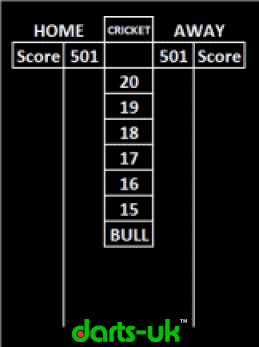
Checkouts and ways to finish '01 dart games

That’s the way to do it!
As Bobby George says “trebles for show and doubles for dough!” Finishing games are what it all about! It’s great when you can score high but if you can’t finish you are not going to win!
Many people when first starting to play find it difficult to remember combination checkouts. Some combinations are better than others purely because if you miss the first shot you may still be in line for an easy single then double to finish. But knowing how and why can make the difference of winning or losing. This again can depend on what is the best three dart finish or two dart finish! Scholars of the board may give different opinions and their preferred combination route.
To get you started here is an example showing a couple of options facing a dart-thrower.
Example:
To win you need 77 and must finish on a double! 77 can be finished by hitting treble 15, double 16, one of the nicest doubles on the board. But what if you hit a single 15? This leaves you with 62, - Single 12 Bull? , Treble 10 double 16? Both are not easy to hit. But what if you decided to go for 77 a different way? Treble 19, double 10? And you missed treble 19 but hit the single? Then this still leaves you a shot at single 18 then double 20. This seems a better route and there are many shots similar to this. There are also a number of ways to finish and below just give you one way, but not necessarily the best when you have three darts for a two-dart finish.

The checkout sheet I have produced will help new players and players that find it hard to remember out shots. The checkout sheet is FREE to download and use. So why not place one up near your board in your club so it helps you or others improve their game!
Many games are still scored using marker pen and paper or marker pen and whiteboard or even chalk and a chalkboard. Professional matches are still scored this way. The only current exception is the TV/ Stage stages of BDO events when they now opt to use a computerised scoring system.
Now That’s the way to do it!
The Darts-UK checkout chart is in PDF and designed to fit A4 paper. Download it here:
Dart Averages
The dart average gives an indication of a dart thrower's darting ability. The higher the average normally indicates the better player. It is quite easy to calculate dart averages; basically, you just divide the score hit by the number of darts thrown. Over a match that has several legs, the average is calculated over the entire match, not by a single leg. I have shown a printable example of how to calculate a single leg of 501 but if you lose the game what is your average? This is easy to work out just divide the total score obtained by the darts thrown e.g. 400 scored in 15 darts = 26.67 per dart or 80.01 per throw. If you are calculating a match that is over several legs then the calculation is the same. Just total the number of points scored by the number of darts thrown.
An example of a three-leg match, each leg 501
Leg One: Player 'A' wins in 18 darts, Player 'B' scores 401 with 15 darts. Leg Two: Player' A 'loses, scores 469 with 21 darts, player 'B' wins in 22 darts Leg Three: Player 'A' wins in 17 darts, player 'B' scores 424 in 16 darts.
Match Averages
Player 'A' scored a total of 1,471 with 56 darts their average per dart = 26.27. This is usually expressed in TV darts as a three dart throw, therefore, 78.81.
Player 'B' scored a total of 1,326 with 53 darts their average per dart = 25.02 their three-dart average would be 75.06.
Also, some TV events (BD0) will show the first 9 dart average as well as the overall average.This is to show how good or bad the scoring power of a player may be. Shots at double are sometimes shown as an average statistic and this is worked out in the same way.